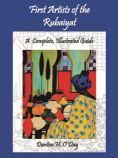The Crowded Borderlands of an Iconic “Translation”: Material and Immaterial Paratext of FitzGerald’s Rubaiyat of Omar Khayyam. Christine Ruymbeke
In: The Routledge Handbook of Persian Literary Translation. Shabani-Jadidi, Pouneh; Higgings, Patricia J.; Quat, Michelle (eds.) London, Routledge, 2022. ISBN: 9781003052197
Archives
Khayyam studies in Russia
Khayyam studies in Russia. Sultanova Zulkhumor Sabatullaevna.
In: Anglisticum. Journal of the Association-Institute for English Language and American Studies, 11 (2022) 12, p. 34-40
Omar Khayyám. Una strada verso l’unità dell ‘essere e del sentire
Omar Khayyám. Una strada verso l’unità dell ‘essere e del sentire. Dario Chioli. Prima edizione: 5/1/2001; Ultimo aggiornamento: 7/2/2022
Discussion and survey of Italian translations and translators of the Rubáiyat. Contains extensive bibliographic details.
First Artists of the Rubaiyat
First Artists of the Rubaiyat : A Complete Illustrated Guide. Danton O’Day. Emeritus Press, 2022. vi, 212 p. ISBN: 979-8-21-032614-0
Summary:
The book is a complete catalog of early artists of Edward FitzGerald’s Rubaiyat of Omar Khayyam and it offers a cornucopia of visual delights and discoveries. Hundreds of pictures by over 200 artists: photographs, oil paintings, watercolours, etchings, woodcuts, line drawings, calligraphy provide unique insight into the poetry and add beauty to one of the world’s most popular collections of verse. Many new artists are revealed with dozens of women artists identified.
